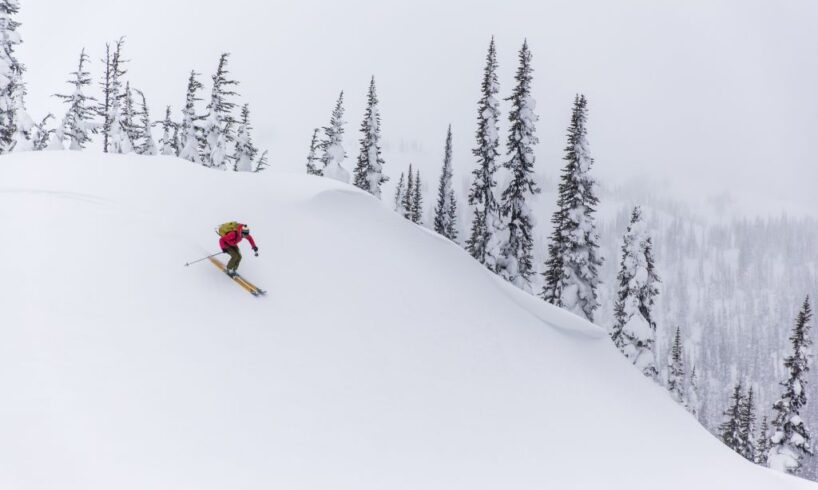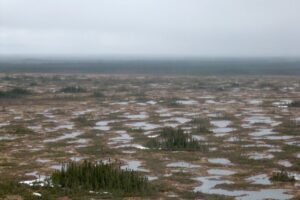
A proposed ski resort in the heart of B.C.’s Interior won’t undergo a full environmental assessment despite concerns it could threaten critical habitat for grizzlies, wolverines and other wildlife. Instead, the Zincton resort proposal is being reviewed by the Ministry of Tourism, Arts and Culture’s mountain resorts branch.
The Zincton Mountain Village would cover 4,500 hectares of private and Crown land in the Goat Range of the Selkirk Mountains in the Central Kootenays, about 16 kilometres east of New Denver, B.C.
The resort was put forward by David Harley, founder of Valhalla Pure Outfitters, in December 2019. Zincton would be “a radical departure from existing resorts” with a focus on human-powered backcountry experiences, according to Harley’s press release, with backcountry skiing in the winter and mountain biking in the summer.
Critics worry the resort could have significant impacts on Slocan Valley ecosystems. With beds for an estimated 1,700 guests, the Zincton proposal falls short of the 2,000-bed threshold that would automatically trigger a full environmental assessment.
Harley did not respond to questions from The Narwhal by publication time.
The Selkirk Mountains are a popular backcountry skiing destination. The proposed Zincton Mountain Village would cover 4,500 hectares of private and Crown land in the Goat Range of the mountains, offering skiiing in the winter and mountain biking in the summer. Photo: David Moskowitz / The Narwhal
In November 2024, Kootenay-based environmental group Wildsight wrote to provincial cabinet ministers to request the Zincton resort proposal undergo an environmental assessment to adequately evaluate its potential impacts on wildlife, watersheds and local traffic — impacts the group worries the mountain resorts branch review could fail to capture.
In February 2024, the Sn̓ʕaýckstx (Sinixt) Confederacy — whose traditional territory includes the area where the Zincton resort would be built — also called on the government to complete an environmental assessment for the project.
“All impacts associated with the project must be considered in order to have a properly informed review and decision-making process,” Jarred-Michael Erickson, a spokesperson for the confederacy, wrote in a letter to the relevant ministers.
However, on July 24, chief executive assessment officer Alex MacLennan concluded sending the Zincton proposal through an environmental assessment “would be duplicative and is not required.”
“I am satisfied that the major projects review process led by the mountain resorts branch can fairly, effectively and appropriately address the concerns raised in the applications,” MacLennan wrote in his report rejecting the request for an environmental assessment.
‘It really deserves better protection’
Cindy Marchand, secretary of the executive committee at the Sn̓ʕaýckstx (Sinixt) Confederacy, called the decision wrong and said it ignores the perspective of the Sinixt.
“We do firmly believe that an environmental assessment based on scientific facts would be the best approach to study this critical wildlife habitat and the effects this could potentially cause,” Marchand told The Narwhal in an interview.
Simon Wiebe, Wildsight’s mining impacts and policy researcher, called the office’s decision disappointing.
“It was disappointing for them to not value this amazing, amazing ecosystem,” Wiebe said in an interview. “[The] Slocan Valley is a beautiful area that has been impacted by mining and by logging by other industries, and it really deserves better protection.”
Grizzly bears are just one of the many local species that call the Selkirk Mountain Range their home. Photo: David Moskowitz / The Narwhal
Wolverines in Western Canada are listed as a species of concern under the Species at Risk Act. Photo: David Moskowitz / The Narwhal
The Ktunaxa Nation has also expressed concerns about the project. In 2023, the nation conducted its own evaluation of the potential effects recreational developments, including Zincton, could have on the North Slocan Valley. The resulting report concluded that boosting recreational access to the local backcountry would degrade and disrupt the habitat of grizzly, wolverine, moose, mountain goat and western toad populations.
“Results of this assessment find the cumulative effects of existing and proposed land-use activities within this narrow and vital corridor are considered high hazard,” the report stated.
Zincton’s review won’t be as stringent as it could be, critics say
Only projects that meet or exceed certain thresholds — like the 2,000-bed requirement for major resort proposals — are automatically evaluated under B.C.’s Environmental Assessment Act to determine how they could impact local ecosystems, communities and Indigenous Rights.
“Environmental assessments under the Environmental Assessment Act are intended for major projects with the greatest potential for significant adverse effects, without duplicating existing regulatory frameworks,” according to the environmental assessment office.
If a project doesn’t meet the legislated threshold, it will instead be reviewed by a dedicated office in another ministry, like the mountain resorts branch. From the branch, Zincton will receive a review similar to the environmental assessment office’s, taking into account potential environmental effects, First Nations Rights and economic factors.
But — like the projects it is designed to evaluate — the environmental assessment process is a step up from the evaluations done by other offices. It includes more detailed studies of a project’s potential environmental impacts, as well as more opportunities for First Nations and members of the public to weigh in.
Wiebe considers it the most stringent process for evaluating potential project impacts. With his background in mining, Wiebe worries Zincton’s construction could stir up sediment and debris from old mining operations in the valley, potentially unleashing contaminants that have sat undisturbed and relatively harmless for decades.
Several local First Nations have raised concerns about the Zincton project, including the Sn̓ʕaýckstx (Sinixt) Confederacy, whose traditional territory the resort would be on, and the Ktunaxa Nation. Photo: David Moskowitz / The Narwhal
“Without an environmental assessment studying the geomorphology and the sedimentology of how this construction process will affect downstream ecosystems, we don’t know what’s going to happen,” he said. “A big part of why we want the environmental assessment is because this is a contaminated site, and it’s currently somewhat benign. If we’re stirring up all these things, is this going to impact the downstream ecosystems?”
The environmental assessment process also provides funding to support First Nations participating in the review, something the mountain resorts branch review does not include.
“Without this environmental assessment, we feel like this process is going to move forward without getting involvement from not only us, but other Indigenous nations, and not getting that Indigenous perspective,” Marchand said.
Ministry review will continue with no timeline to wrap up
So what comes next for the Zincton resort proposal?
According to the mountain resorts branch, the office is awaiting the proponent’s response to feedback on its environmental overview assessment for the project. Despite Harley’s hopes that Zincton might be welcoming visitors by the end of 2021, the project is only at the second stage of the branch’s five-stage review process.
The review process will continue “until the risk of potential negative impacts and critical issues are sufficiently addressed,” the branch stated, noting that there is no timeline for it to be completed.
Marchand said the confederacy will continue to push for Zincton’s impacts to be fully evaluated.
“This area is way too important to us. It’s also important to sensitive wildlife, such as the grizzly bears, the wolverines, the caribou, the mountain goats,” she said. “This is definitely something we’re not giving up on.”
Wildsight will also be keeping a close eye on the project’s review, Wiebe said.
“We’re just hoping to push forward with a robust mountain resorts branch process, which is unfortunate,” he said. “It’s not what we wanted, and that’s not what’s probably best for local communities, but we’re going to continue to stay engaged.”





